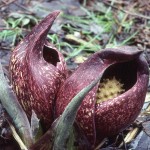
Skunk Cabbage inflorescences in full bloom; the small flowers are clustered on the stalk surrounded by the reddish bract.
Spring is almost here and very soon we will be in the midst of the spring floral explosion. Our Herbarium is well-represented for the spring flora of Ohio, with collections back to 1840. The strategy for many of our spring-flowering species is to emerge early, flower, and complete their annual growth cycle by summer. They avoid the closed-canopy months when much less light penetrates to the forest floor and are already dormant and ready for next year by July. But not everything that flowers early uses this strategy. One of our earliest species to flower is Skunk Cabbage (Symplocarpus foetidus). This inhabitant of wet, swampy woods is a member of a family that is most diverse in the tropics, although we have a few members at this latitude (such as Jack-in-the Pulpit, Arisaema). Skunk Cabbage inflorescences sometimes emerge when there is still snow on the ground and will melt through the snow because they generate heat to volatilize their fragrance compounds that are attractive to flies. The leaves develop after the inflorescences and are large, making the plant up to four feet across. They have a strong skunky odor, especially when crushed, giving the plant its name. The leaves persist throughout the summer.
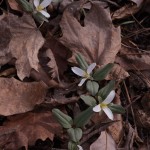
Snow Trilliums are easy to see because they are one of the first plants to flower on the forest floor.
One of our most special native spring plants in central Ohio is the Snow Trillium (T. nivale). It is a small species, only about three inches tall, and it normally flowers at the end of March. It has a rather special niche – bluffs over the floodplains of rivers. It is an uncommon plant, but can be quite abundant when present, sometimes occurring in the thousands. The plant was named in 1835 by John Riddell and the type locality is along the Scioto River just north of Columbus. The species occurs from Pennsylvania west to Iowa and from Minnesota south to Missouri. This is one species that is by far easiest to find when in flower. As soon as taller plants overshadow it, it becomes impossible to see and by summer it is in fruit and then gone until next year.

Harbinger-of-Spring is inconspicuous because of its small size and not-very-showy flowers. The plants are about 3 inches tall.
Another of the very earliest native species to flower is Harbinger-of-Spring (Erigenia bulbosa). It might not seem like it at first glance, but this is a member of the Carrot Family (Apiaceae). The inflorescence is much reduced compared to most members of that family, but the leaves are divided as is typical and the fruits are just right. This species typically flowers in March and is found in rich woods, along with many of our other spring wildflowers, but is in bloom before most of them.
Bloodroot (Sanguinaria canadensis) is a member of the Poppy family (Papaveraceae) and gets its common name from the red sap in the rhizome. Unfortunately, the flowers do not last long. Wind or rain will make them lose their petals particularly fast – so enjoy them while you can.

Putty-root leaves are conspicuously green against brown leaves, or as here, snow. Last year’s fruiting stalk persists.
Two of our native species of orchids are plants that you can see right now – and throughout the winter – because their leaves are present during the winter and stand out in green contrast to the brown leaves of the forest floor. These are Putty-root (Aplectrum hyemale) and Cranefly Orchid (Tipularia discolor). They are an example of a very different way of dealing with the summer closed canopy that most of our spring natives. With both of these species, leaves emerge in autumn and are able to photosynthesize in the relatively bright light during periods of winter when there is no snow and the temperatures are milder. The leaves in both of these species whither by the beginning of summer. Puttyroot flowers typically in May in central Ohio and Cranefly Orchid in August, at which time it also stands out because few species are in flower in the forest shade at that time of year. Puttyroot leaves have fine white striping on the upper side and are green below, whereas Cranefly Orchid leaves are green above and intense purple below.
About the Author: Dr. John Freudenstein is a Professor in the Department of Evolution, Ecology and Organismal Biology and Director of the OSU Herbarium. All photos are by the author except for the Aplectrum leaves and Tipularia flowers, which are by Erich DeLin.
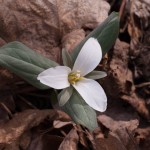

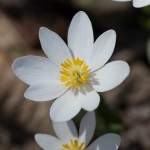

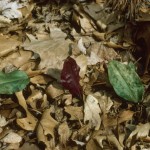
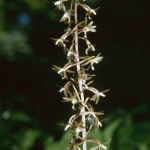
I appreciate how inclusive the community is. Pututogel